Key Takeaways:
- Colors influence mood more than most people guess.
- Warm tones like reds and oranges can spark energy and boldness.
- Cool hues, such as blues or greens, may calm the mind and encourage focus.
- Practical makeup tips revolve around balancing your skin’s undertone with a chosen color scheme.
- Clever color placement brings confidence by highlighting your best features.
- Subtle or vibrant, each shade can shift how you carry yourself throughout the day.
- Testing new colors is a fun way to discover fresh aspects of your personality.

I remember the time I tried an electric-blue eyeliner just for kicks. My best friend said I looked kinda cosmic, and I realized that color alone can change how people see us. Are you curious how colors link to mood or how certain shades make you feel fearless? Let’s talk about color psychology in makeup, how to pick the right hues, and why each color might shift your confidence.
Below, you’ll find 14 sections, each with three subsections. This piece offers step-by-step tips, small technical pointers, and some surprising ideas for how color interacts with our daily style. Let’s jump in.
1. Understanding Colors and Emotions
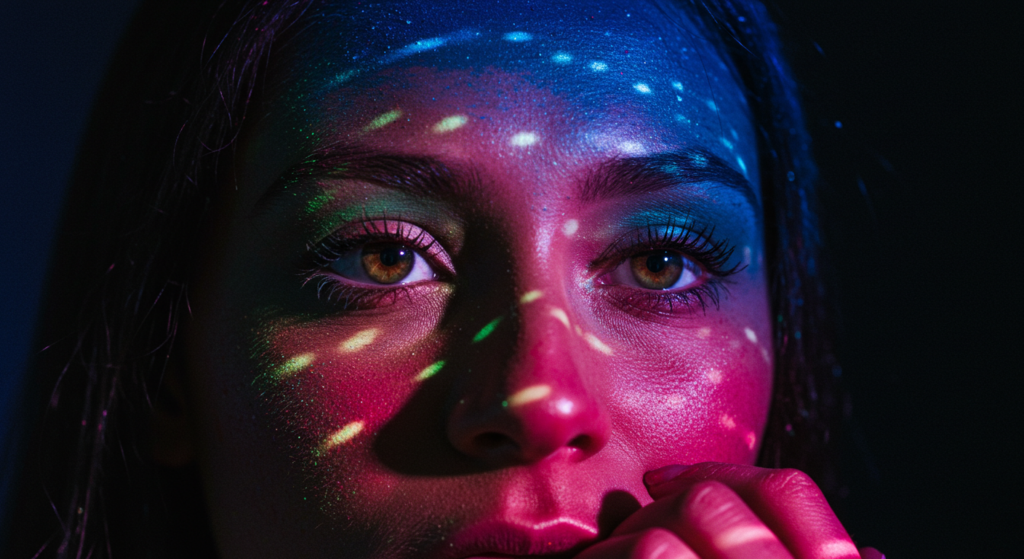
1.1 The Hidden Impact of Color
Color is sneaky. Sometimes, you toss on a hot-pink lipstick and feel unstoppable, but you’re not totally sure why. Maybe you’ve asked: Is it my outfit or the color alone? Colors carry subtle messages that our brains read before we even realize. This effect can shape how we interpret someone’s mood, how we perceive ourselves, or the vibe we send out. Some folks never notice it, but it’s always there.
Why is color so powerful? It’s partly because our brains have formed links between certain hues and emotional cues over countless years. For instance, bright red might say “alert” because it hints at energy. It’s not magic. It’s part cultural, part biology. Embrace it, and your makeup game can shoot up to new heights. Or do you prefer something calmer? Then you might want to slip into dusty pastels. The choice is yours.
1.2 Why Humans React to Colors
Have you ever stared at a teal ocean and felt strangely at peace? Colors spark real emotional signals in the mind. This can be explained by how our sight is tied to our emotional responses. Some color experts suggest that red speeds the heart rate, while green or light blue calms it. Although this is not a strict rule, it’s a helpful guideline for choosing your daily makeup palette.
We see color. Then we react. Some of that reaction is personal preference, and some is social background. For instance, in certain places, white might symbolize purity, while in another place it has a different meaning. Does that mean you must follow some strict color code for your eye shadow? No, but it helps to realize we each carry color associations in our minds. Next time you pick a lipstick shade, ask if that color sparks the exact emotion you want.
1.3 People’s Moods and Makeup Shades
Our moods shift a lot each day. We can wake up feeling unstoppable or maybe sluggish. Makeup color can help us realign or amplify those feelings. If you want a confidence boost for an afternoon meeting, you might choose a bold red lip. If you want calm vibes during a big family gathering, you can pick a gentle peach shade that won’t feel too loud. Think of it as painting your emotional tone for the day.
We sometimes ask: Does color really matter that much? Possibly yes. Many of us find that the color we wear around the eyes, cheeks, or lips makes a difference in how we carry ourselves. And that difference might be small or big, but even a subtle shift can shape your presence in a room. When your color choice matches your intention, you’ll probably feel more steady in your own skin.
2. Reds and Oranges
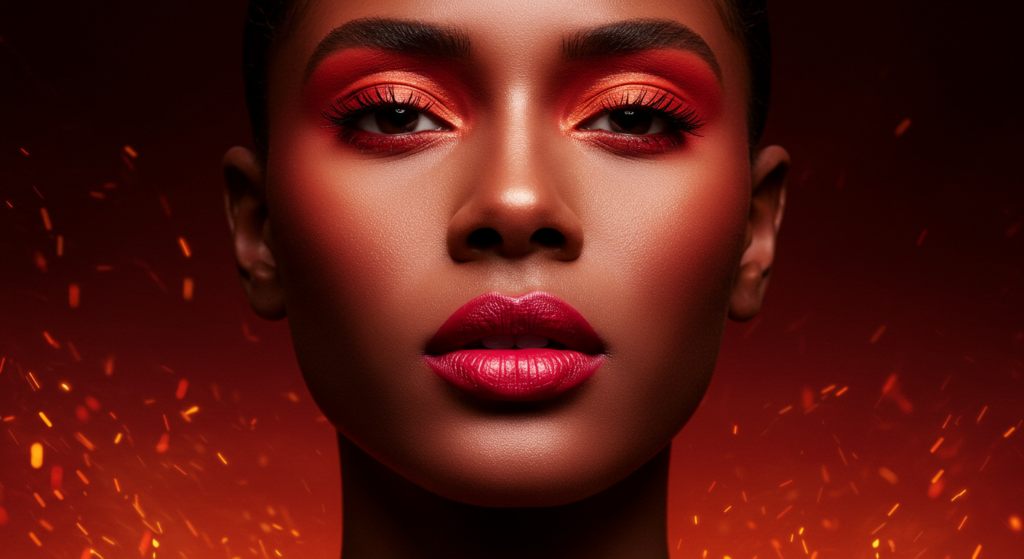
2.1 Warm Tones to Boost Energy
Reds and oranges often remind us of fire, sun, and passion. If you love standing out, you might gravitate to these bright shades. Red lipstick is a classic choice because it radiates confidence and might spark that unstoppable vibe. But you can also test a soft orange blush to freshen your cheeks. People sometimes fear bright colors. They worry that they’ll look too “extra.” But guess what? A vivid lip or wash of color can instantly liven your face.
What if you have a cooler undertone? Warm reds or oranges might still suit you if they’re balanced with a slight blue undertone or if you apply them more lightly. You can also try mixing a deeper red lipstick with a neutral lip liner to calm the color. That way, you can enjoy the bold factor without feeling like it’s too much for comfort.
2.2 Confident Coral Lips
Coral is somewhere between pink and orange, but it has that fresh, breezy glow. Folks who hate fully orange lipstick might settle for a coral shade, which is easier to wear for many skin tones. A quick question: Should you buy a matte or a glossy coral? If your lips tend to be dry, a glossy or creamy coral can look more forgiving, plus it can create a lively finish.
When wearing coral, pair it with a subtle eye. A smoky charcoal liner might clash, so a softer neutral (like a brown or taupe) pairs better. Coral on the lips is bright, so you don’t want your eyes to shout louder than your mouth. If you want a matching blush, pick a gentle peachy-coral tone. It can tie the whole look together.
2.3 Subtle Orange Accents
Are you nervous about wearing orange? You could try it in small ways. Maybe dab a tiny bit of orange shadow on the center of your lid. Or try a tangerine liner for a playful cat-eye. You can also combine orange with earthy browns to create a more wearable gradient. If you want to go bolder, opt for a full wash of bright orange across your lid and keep your lips nude.
Sometimes, we worry that orange might highlight redness in our skin or make our eyes look tired. The trick is to use the right shade of orange and conceal any under-eye circles. You might find that a creamy burnt-orange eyeliner pops best with warm, brown eyes, while a gold-based orange works wonders on hazel eyes. It’s all about fine-tuning the color for you.
3. Pink Power
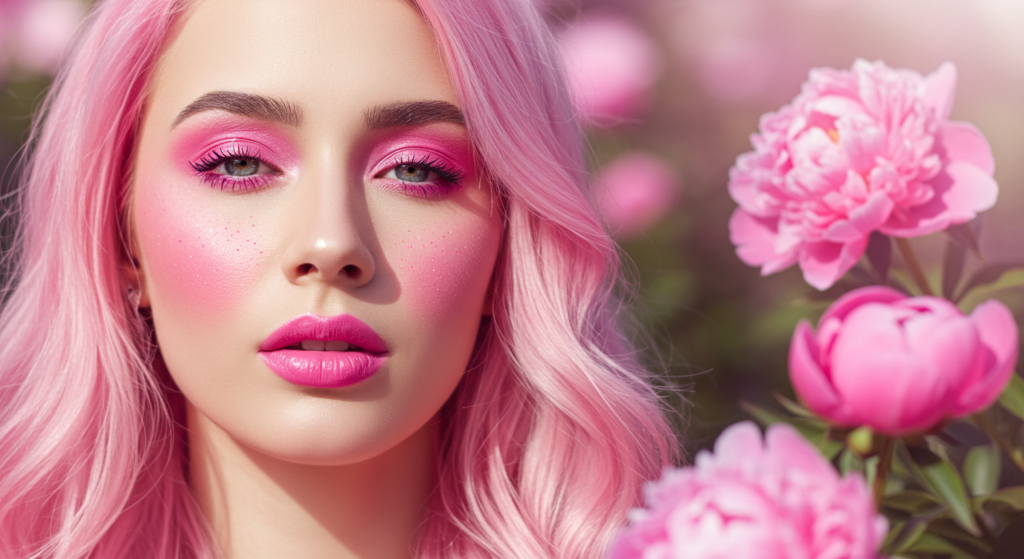
3.1 Romantic Rosy Hues
Pink often gets labeled as “sweet” or “feminine,” but it’s more flexible than that. It can range from baby pink to deep magenta. Have you ever tried a pastel pink highlight on your cheekbones? It can create a soft, angelic glow. Then again, do you want a bright fuchsia pout to show off your fun side? Pink is a wide playground.
The emotional association of pink often leans toward warmth and affection. If you want your makeup to whisper kindness, pink might be the best pick. However, you don’t need to transform into cotton candy. Layering pink with a slightly mauve or dusty rose tone can keep it sophisticated. If you feel too washed out, a quick fix is to add a stronger lip or define the eyes a bit more.
3.2 Barbie Blush vs. Fuchsia Fun
Barbie pink is that iconic bright pink—some might even call it bubblegum. For certain folks, it can look youthful and energetic. Yet, it might be tricky if your skin has a golden undertone. In that case, you might prefer a warmer, fuchsia-leaning shade. Fuchsia is deeper, with a bit of purple tint. It can pop against medium or deep skin tones and look vibrant yet balanced.
One question often arises: Can I mix pink with red clothes? Maybe you remember the old advice that said no. But color rules shift. If you rock a bold pink lip while wearing red, you can look fresh as long as you keep the rest of the face simple. Or pick subtle pink blush if you’re wearing a bright red dress. Contrasts can be striking if done well.
3.3 Best Occasions to Rock Pink
Pink is great for day or night. If you’re going for brunch, a soft pastel pink lip or a barely-there pink cheek can be gentle and sweet. If you’re heading to a music night with friends, hot pink lipstick can stand out. Weddings are also a classic moment for pink—especially if the bride wants a romantic vibe.
People often ask if pink is too youthful for older individuals. Age shouldn’t limit your choice. A dusty rose can look elegant on anyone. If you find yourself worried about looking “too girly,” you can pick a toned-down pink. Makeup is personal. The main thing is to choose a pink that fits how you feel inside. If it’s right, you’ll know as soon as you see your reflection.
4. Cool Blues and Greens
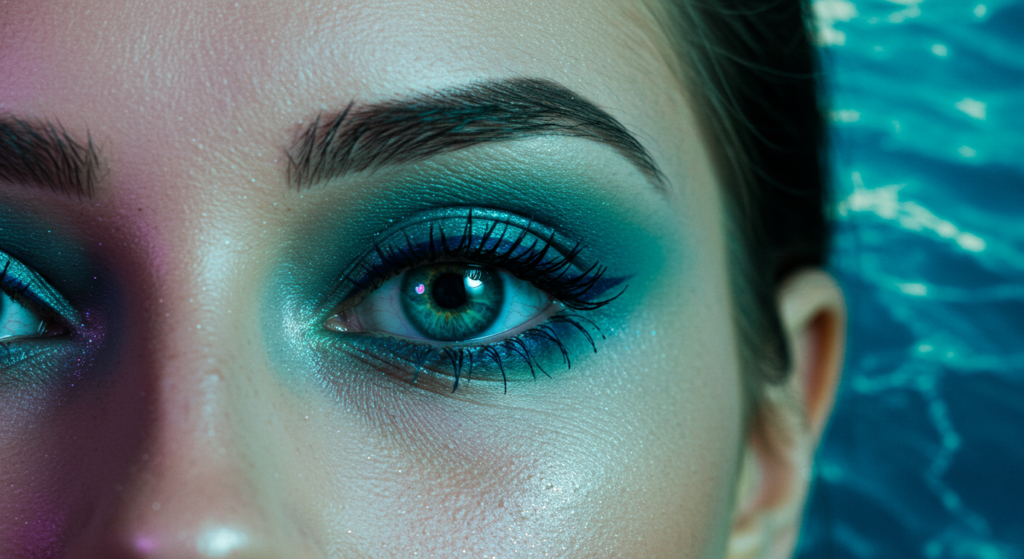
4.1 Blues That Soothe or Energize
Blue can be tricky. Some folks think it’s only for nails or daring shadows. Actually, light blue liner can make brown eyes sparkle, and a deeper navy shadow might look smoky yet less harsh than black. Will it look dated? Not if you use a modern formula with subtle shimmer or a matte finish. The trick is to keep the rest of your face neutral so the blue takes center stage.
Soft baby blue is associated with calmness, while a bright cobalt might feel more outgoing. Don’t be shy about mixing textures, like a cobalt liner with a tiny flick at the corners. If you’re doing a strong blue eye, skip bold lip colors that might compete. Sometimes a simple nude gloss is all you need.
4.2 Greens for Balance
Green can represent growth or freshness. Though we must avoid the word “evolve,” many people sense that wearing green eyeshadow or eyeliner adds a nature-inspired vibe. Are you worried it might appear too theatrical? You can pick an earthy olive shade and pair it with warm browns for a low-key smoky effect. Or maybe you want an emerald shimmer on the center of the lid for a more glamorous look.
Another question arises: Is green flattering on everyone? It can be. If you have hazel eyes, green can highlight their gold flecks. If you have blue eyes, a deeper forest green can create contrast. For brown eyes, bright jade might pop. Test different shades. One little tip: if you want your green makeup to stand out, try wearing a neutral or black outfit so the color gets all the attention.
4.3 When Blue and Green Combine
Mixing blues and greens can create a mermaid-like fantasy. You might use a lighter teal in the inner corner and blend into navy in the outer corner. That gradient can look quite enchanting. For a simpler version, choose a teal liner for your upper lash line, then a gentle wash of matching green or blue across the lid.
Another approach is to match your accessories. Maybe your handbag has turquoise details, so you add a faint turquoise highlight on your lower lash line. If you want a more intense vibe, you can add a greenish glitter on your lids for a night event. The key is not to overdo it with your lip color. A simple nude lip, maybe with a slight pink tone, keeps the focus on your mesmerizing eyes.
5. Purple and Lavender Magic

5.1 Regal Appeal of Purple
Purple often stands for creativity or boldness. It has an air of mystery. A plum lipstick can be surprisingly flattering, especially for deeper skin tones. Even for lighter complexions, a cool-toned purple lip can create a striking statement. The question is: Does purple clash with pinkish skin? Sometimes it can wash you out, so you might need to anchor it with a darker lip liner or a deeper blush.
When you apply purple eyeshadow, consider the intensity. A lavender pastel can look airy and sweet. A deep violet can look regal and moody. If you’ve ever used a purple eyeliner, you might have seen how it enhances green or hazel eyes. Purple can also add warmth to brown eyes if the shade is more on the red side of the spectrum.
5.2 Lavender for Subtle Sophistication
Lavender is lighter, more delicate, and can be a great pick for daytime events. If you’re timid about color, a gentle lavender shadow can add a fresh wash without overpowering your features. Pair it with a soft, fluffy mascara to keep the look light. Have you tried layering a pinkish highlighter over the top of lavender shadow? It creates a duo-chrome effect that sparkles in certain angles.
One small caution: lavender can sometimes bring out under-eye darkness. So if you’ve got some eye baggage, make sure to conceal or color-correct. That way, your shadow stays uplifting and doesn’t highlight any unwanted circles. For lips, a soft pink or subtle nude might be best to avoid clashing with the cool tone of lavender.
5.3 Mixing Purple with Other Shades
What if you love purple but want to incorporate other colors too? One idea is to combine purple with gold. The warm sparkle of gold can offset the coolness of purple. You can layer gold on the inner corner of your eyes, then blend purple into the outer half. Or pair purple lipstick with a gold-hued highlighter for a luminous glow across your cheekbones.
Some people also like to add teal or green accents with purple for a more whimsical palette. That might work great for a summer festival or a costume party. The important point is to blend well so you don’t have harsh lines between the colors. If your purple lip is very dark, keep your eye makeup minimal or neutral to balance the intensity.
6. Neutral Tones for Everyday Confidence
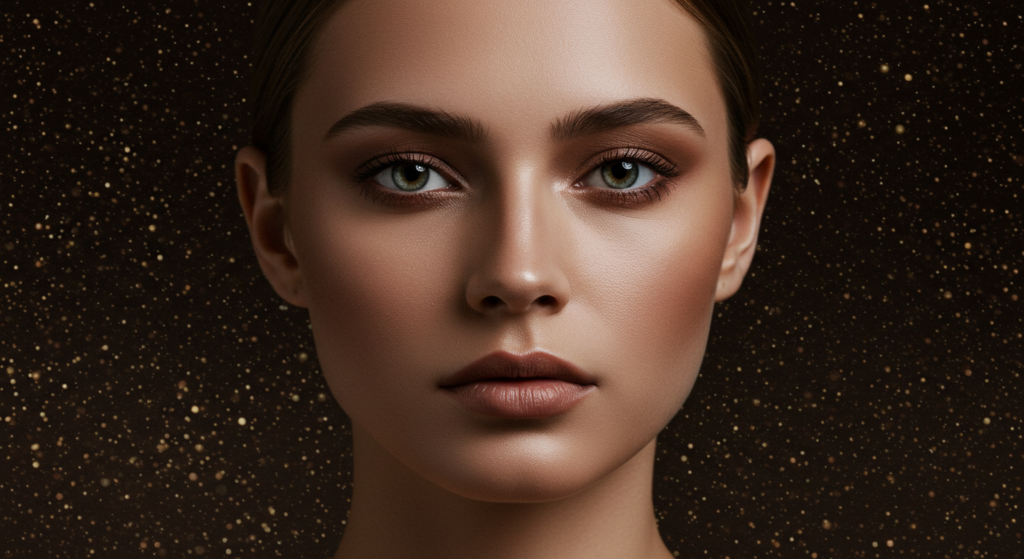
6.1 Brown, Beige, and Taupe Options
Neutral colors sound boring until you realize how versatile they are. A subtle brown can define your crease, shape your eyebrows, or double as a soft eyeliner. A warm beige can be used on the lids for a polished look. Taupe lies somewhere between gray and brown, making it a cool neutral that suits many undertones.
The biggest advantage of neutrals is that they can give you a refined look without stealing the spotlight. If you’re heading to a job interview or an important meeting, neutrals can help you appear put-together. Are you concerned about looking bland? You can always add a flick of metallic shimmer or a hint of color in your mascara to spice things up.
6.2 Subtle Definition with Browns
Brown eyeliner and mascara can appear more natural than black. This subtle shift can soften your face. It’s often beneficial if you want a daytime look or if your complexion is light. You can also use different shades of brown to contour your eye shape or carve out your cheekbones with bronzer.
One trick I like: Take a mid-tone brown eyeshadow and apply it along your lower lash line with a smudger brush. It adds definition but doesn’t shout like a black liner. Then, pair it with a dusty rose lipstick or a light gloss. The result is polished, fresh, and almost no one can guess you spent extra minutes blending in the mirror.
6.3 When Neutral Meets a Pop of Color
Neutrals don’t have to be alone. You can create a base using browns and taupes, then add a pop of color in a strategic spot—like a bright purple eyeliner on your waterline or a vivid pink lip. This technique works because the neutral backdrop enhances the color’s brightness.
Do you feel uncertain about wearing color in your daily routine? Start small. Maybe just a bold lip with a neutral eye. Or a neutral lip with a neon eyeliner. These little combinations let you see how color changes your mood. If you find a combo that makes you smile, keep going.
7. The Power of Metallics
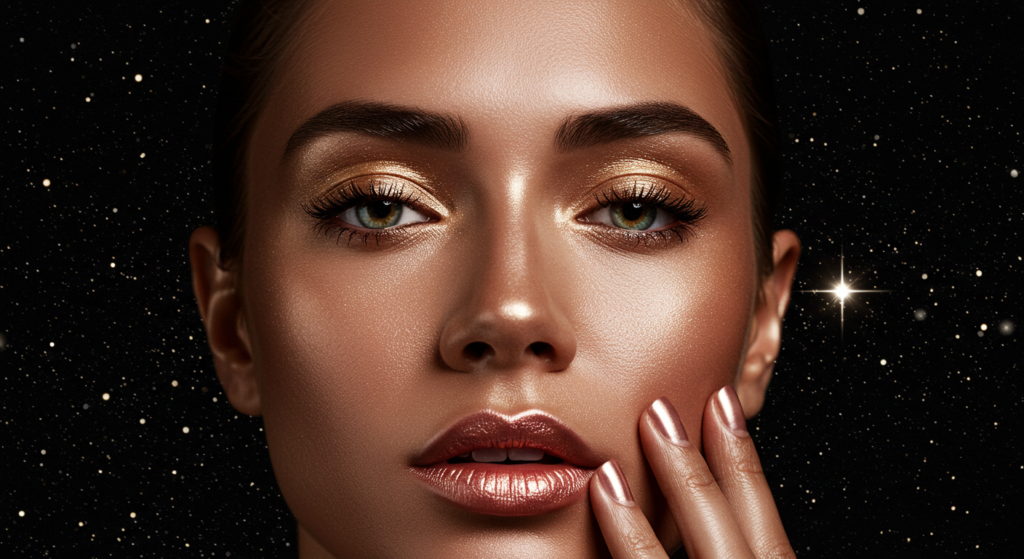
7.1 Gold and Rose Gold Highlights
Metallics catch the light in a magical way. Gold and rose gold can warm up your complexion. A little gold highlight on the inner corner of your eye can make you look more awake. Rose gold, with its subtle pink tones, can feel feminine without being too much. Use a light hand, as metallic can quickly shift into a dramatic look if overapplied.
Many highlighters come in gold or rose gold versions. If your skin is warm-toned, gold might complement you best. If it’s cooler, rose gold might blend more gracefully. Are you thinking: What if I’m neutral-toned? You might get away with either. Testing is the only way to know. Place a tiny amount on your cheekbones and see which one melts into your skin better.
7.2 Silver and Platinum Sparkles
Silver has a crisp, icy vibe. If you’re going for a futuristic or edgy look, silver can be a strong choice. For instance, a silver eyeliner along the top lash line can look interesting at night events. Or you can add silver glitter to the center of a smoky eye. Another approach is a metallic silver lip topper over a matte lipstick to create a reflective sheen.
Does silver work for warm skin? It can, but it may stand out more. Some warm-toned folks prefer champagne or gold-based metallics. If your heart longs for silver, you can still rock it. Just blend it with a slightly taupe or cool brown shadow so the transition isn’t jarring. Also, keep your cheeks warmed up with a bronzer or peachy blush.
7.3 Balancing Metallic Intensity
Metallic is bold by nature. A small smidge can be enough for daytime. If you’re heading out at night, you can add heavier metal finishes on the eyes or lips. One approach is to pick only one metallic focal point. For example, if you opt for a gold foil lid, keep your lips matte. Or if you want a metallic lip, keep your eyes mostly matte or gently shimmering.
Working with metallic products can be tricky. They often accentuate texture on the skin. So if you have dryness or fine lines, you might want to use a smoothing primer first. Also, consider your lighting. Metallic makeup looks amazing under warm, soft lights but might appear harsh under bright or fluorescent lighting. A quick check in a mirror can save you from an unexpected disco-ball effect.
8. Color Correcting and Concealing
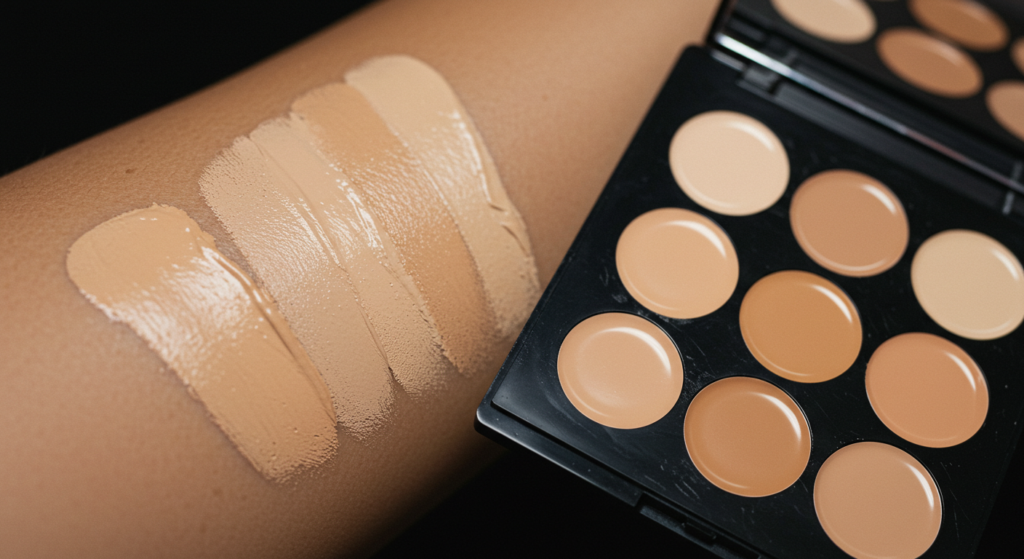
8.1 Basic Color Theory for Concealer
Color correction is essential if you want to neutralize dark circles, redness, or pigmentation. Green concealer can cancel out red spots, orange or peach concealer can minimize blue or purple under-eye circles, and purple concealer can balance sallow skin. Do we absolutely need color correctors? Not always. But they can help if you’re facing specific issues that regular concealer can’t handle alone.
Using a peach or salmon corrector under your eyes might help hide that tired look. Then you apply your normal concealer on top. A common mistake is to use too much corrector and end up with patchy skin. Use a tiny amount in the exact area that needs correction, then blend gently so the product stays where it’s needed.
8.2 Blending Techniques
If you apply color corrector, you might be worried about that weird tinted patch on your face. That’s where blending becomes key. Tiny brushes or sponges let you place color exactly. Then gently tap or buff out the edges. You don’t want to smear the color everywhere, or you’ll lose the targeted effect.
Some folks ask: Should I use my fingers for blending? Fingers can warm up the product and help it spread. But if you have very oily skin or large pores, a small brush or beauty sponge might give a more precise result. The best method is the one that looks natural and fits your routine. You can do a quick test on the back of your hand to see how your product sets.
8.3 When to Skip or Use Less
Color correction can be helpful, but sometimes we go overboard. If you only have mild dark circles, a regular concealer might be enough. If you have slight redness around the nose, a standard foundation could cover it. Overdoing correction can lead to a cakey look that isn’t so flattering in daylight.
Listen to your skin. If you have a blemish that’s super red, then a dab of green corrector might be your friend. But if it’s just a tiny spot, your concealer might handle it by itself. The ultimate goal is to even out your skin so that your chosen makeup colors stand out without distraction. Less can be more, especially if you want a fresh finish.
9. Seasonal Color Combinations

9.1 Bright Summer Looks
Summer calls for bright corals, aqua liners, sunny gold highlights, and fun pops of pink. Warmer months often inspire beachy vibes and glowy skin. If you’re heading to a barbecue, you might do a simple coral lip, tinted moisturizer, and a soft orange-y blush. Or use turquoise eyeliner for a cheerful twist. Are you worried about sweat? Go for long-wear or waterproof formulas.
Summer is a great time to experiment with pastel nail colors, too. Mint green, baby pink, or lavender nails can complement your makeup. And if you want that dewy beach glow, try a light cream highlighter on your cheekbones. That’ll catch the sunlight and make you feel glimmery. A light tinted lip balm with SPF can protect your lips and still add color.
9.2 Moody Fall Vibes
Autumn often brings deeper, richer shades like burgundy, chocolate browns, and burnt oranges. A lot of people enjoy the cozy sense of these colors. For eyes, you can do a copper or bronze smoky look. For lips, you might wear a vampy plum or a warm brick red. Pair that with a soft peach blush to balance out the dark lip.
If your skin tends to get drier in fall, prepping your face with a moisturizing primer or lightweight oil might help. Then you can layer your makeup without any patchy areas. Another tip: test a new lipstick shade indoors and outdoors to see how it looks in different lighting. That dark burgundy might appear more intense under natural daylight, so adjust your overall makeup accordingly.
9.3 Winter and Spring Transitions
Winter can push us toward frosty shades like silver, icy blues, or deep berry lips. These shades can exude a cool elegance. Meanwhile, spring is about fresh blooms and lightness, so pastel pinks, lilacs, and soft greens become popular. Are you forced to follow these seasonal guidelines? Of course not. They’re just suggestions for folks who enjoy matching their makeup to the season.
During winter, you could rock a metallic silver or gunmetal eyeshadow with a berry lip. In spring, a pastel peach blush and a glossy pink lip might help you look lively. The seasons often influence our mood, so it’s fun to shift your makeup accordingly. But if you want to wear neon green in the dead of winter, go for it. Let your comfort guide you.
10. Pairing Makeup with Outfits
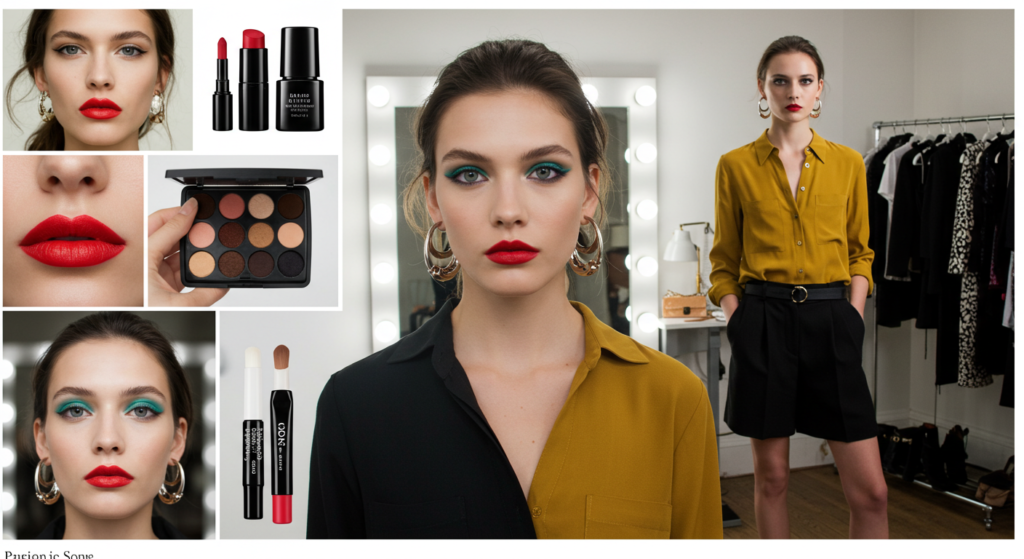
10.1 Complementary Colors
Have you heard of the color wheel? Colors that sit opposite each other on the wheel can complement each other. For instance, if your dress is green, a pinkish lip can pop. If you’re wearing a purple top, a touch of gold or yellow-based shadow on your lids might create a pleasing contrast. This approach can help you figure out how to pair your makeup with your wardrobe.
Sometimes, we match our outfit exactly. But that can feel too matchy-matchy. A better method is to pick complementary or analogous colors. For example, if your shirt is red, you could opt for a subtle greenish liner or a neutral eye with a deeper lip that shares a similar undertone. The idea is to harmonize, not to look like a crayon box.
10.2 Accessory Matching
Another angle is to match your makeup with your accessories. If you have a statement necklace that features turquoise gems, you might include a pop of turquoise liner. Or if your scarf is a bold purple, you might tie that shade into your eyeshadow or lip color. This approach can feel more subtle since you’re not matching your entire outfit—just a small piece.
Do you worry it might be overkill? Keep the rest of your face toned down. Let that one pop of color shine. If you’re wearing gold jewelry, a gold highlight on your cheekbones can tie everything together. That’s the beauty of metallic accents—they coordinate easily with metallic jewelry. Have fun with it. Sometimes a small detail can pull your entire look together.
10.3 Daytime vs. Nighttime
Your outfit might also signal whether your makeup should lean lighter or heavier. A bright floral dress in daytime might look best with fresh, luminous makeup, while a sleek black evening outfit could handle a bold smoky eye or a sultry lip. Of course, if you’re a rebellious spirit, you can ignore these norms. But many people find them helpful as a starting point.
One question pops up: Should I ever do a bold eye and a bold lip together? You can, but it might be too overpowering for many daytime settings. For a special night out, though, a crisp winged liner, sultry smoky eyes, and a bold lip can look spectacular if everything is blended properly. It’s about balance: if you emphasize your eyes heavily, maybe pick a lip color that complements without fighting for attention.
11. Special Occasion Makeup
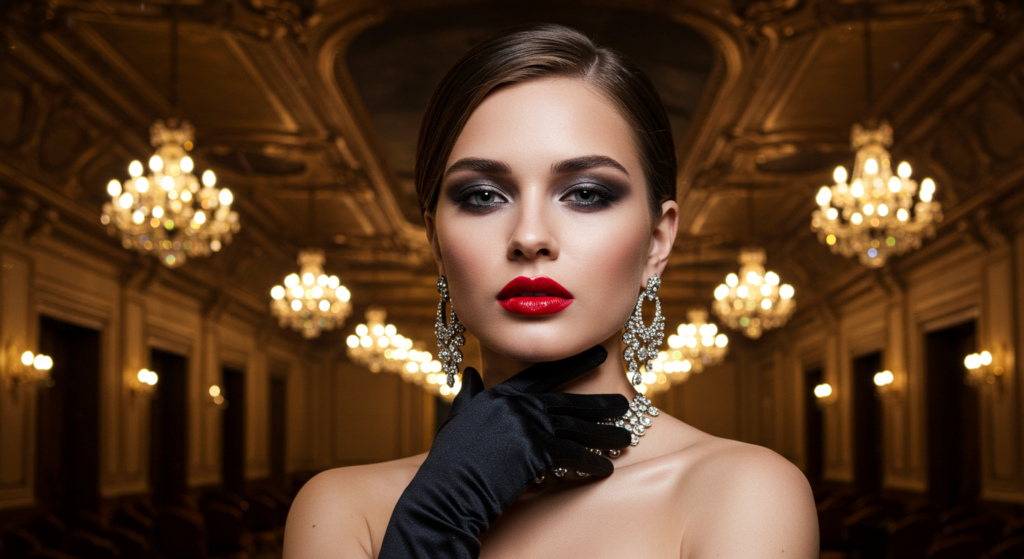
11.1 Weddings and Formal Events
When you’re a guest at a wedding or attending a formal event, you might want a look that lasts all day and doesn’t overshadow the main focus. Neutral or soft glam often shines here. You can incorporate a hint of shimmer on your lid or choose a classic winged liner with a muted lip. Also, if you suspect tears, water-resistant mascara or false lashes that can handle humidity are essential.
One tip: flash photography often washes out colors, so you can go a bit heavier on blush and bronzer than you usually do. But don’t go so heavy that you look unrecognizable in person. Always do a final check in natural light, if possible. You might bring a small pressed powder and your lip color for touch-ups throughout the event.
11.2 Work Presentations and Conferences
When you want to look confident in front of colleagues, the right colors can help. A strong red lip can project authority, or a polished neutral eye can show composure. The best formula is something that won’t require constant upkeep. A long-wear lipstick or a bulletproof matte foundation might serve you well. No one wants to worry about smudges in the middle of a big presentation.
Should you go dramatic for a work conference? It depends on your office culture. If your team is more creative, a bold teal eyeliner might be acceptable. If it’s a strict setting, you might keep it subtle: a classic cat-eye or a mauve lip. The main idea is to feel comfortable. If you’re anxious that your sparkly shadow is too much, that anxiety might show.
11.3 Parties and Night-Out
For parties or nights out with friends, you can unleash your more adventurous side. Try glitters, metallic lips, or bright neon liners. Maybe do a color-block look: a bright purple lid with an orange lip, if you’re feeling flamboyant. Keep your base flawless, so your colors have a nice canvas. A heavier contour might also fit the nighttime vibe.
What about dance parties? Sweat or movement can break down makeup, so consider primers and setting sprays to lock in your look. Also, dark clubs have different lighting that can wash out subtle makeup. Sometimes it’s good to accentuate your features a bit more for such environments. A reflective highlighter or bold lip can be the star of the show under strobe lights.
12. Practical Product Suggestions

12.1 Lip Products
When selecting a lip color, consider the undertone. For instance, a cool-toned red might flatter someone with pinkish skin, while a warm-toned red might suit golden skin. Brands often label shades as “cool” or “warm.” If you’re unsure, look for names like “blue-based red” or “warm orange red.” You might also sample testers at a beauty counter to see how the shade appears on your actual lips.
Matte formulas can appear more intense, while glossy or sheer formulas can look softer. Some folks prefer liquid lipsticks for longevity, while others like the comfort of a cream bullet lipstick. If dryness is a concern, try a tinted balm or a satin lipstick. Check reviews or watch swatches online before buying, especially if you don’t have a physical store nearby.
12.2 Eye Shadows and Liners
A versatile eyeshadow palette usually includes a range of neutral mattes and a few pops of color. This type of palette is perfect for daily wear and special occasions. If you want to explore color psychology, pick a palette with warm reds, cool blues, and maybe a few metallics. Liners come in many forms: pencil, gel, liquid, or felt-tip. Each has its own learning curve.
For a beginner, a pencil might be easiest to control. If you’re comfortable with makeup, a liquid liner can create a sharp, dramatic line. Gel liners can be smudged for a smoky vibe. Considering colored liners? Try a deep purple or navy for a twist on standard black. They can open your eyes in a subtle way that’s noticeable but not shocking.
12.3 Face Products
Foundation, concealer, blush, and highlight form the base of your canvas. If you want your color makeup to pop, a well-prepared base is crucial. Some prefer a full-coverage foundation to blank out imperfections, while others like a tinted moisturizer for a more natural look. Blush choices can vary from peach to pink to deeper berry. Pick one that complements your lip color or your desired vibe.
If you’re testing new colors for your eyes or lips, keep the rest of your face neutral so the color stands out. Or if you want a strong cheek color, pair it with minimal eye makeup. Primers can help the makeup stick better, especially if you have oily skin. Setting sprays or powders can lock in the final look, making your colors last longer without smudging.
13. Skincare Prep for Better Color Payoff
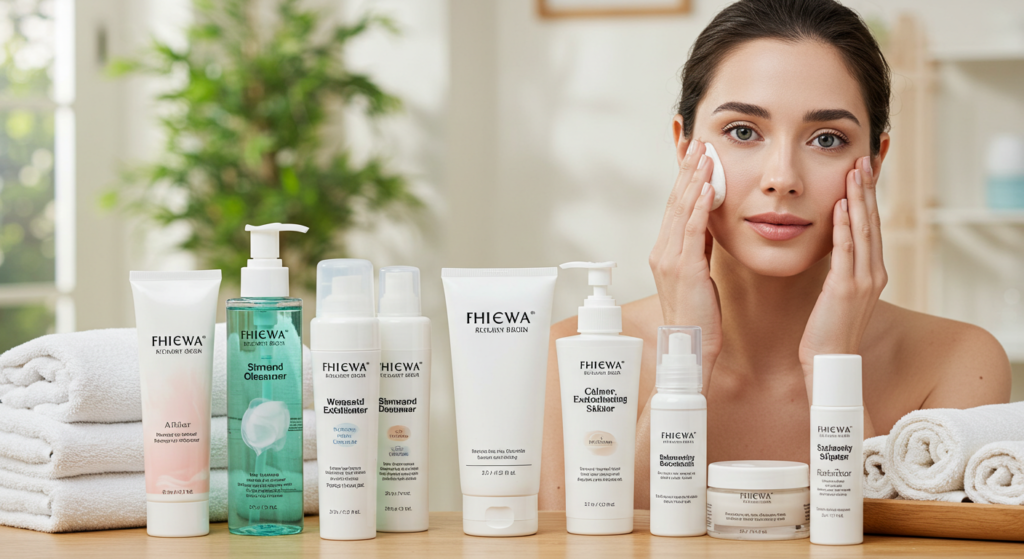
13.1 Cleansing and Exfoliating
Clean, smooth skin is the best backdrop for makeup color. If you have flaky or rough patches, bright colors might cling awkwardly and look patchy. That’s why regular exfoliation is key. You can use a mild scrub or a gentle chemical exfoliant once or twice a week, depending on your skin type. Over-exfoliating might irritate your skin, so don’t go crazy.
Before applying makeup, wash your face with a cleanser suited to your skin. If your skin is dry, pick a moisturizing cleanser. Oily? A gel-based one might help. Then pat your face dry gently. Some people skip exfoliation when they’re short on time, but if you know you’ll be wearing a bold lip or bright eyeshadow, a quick scrub can make a noticeable difference in how smooth everything looks.
13.2 Moisturizing and Priming
After cleansing, apply a moisturizer that fits your skin type. Wait a minute or two for it to sink in. Next, consider a primer. Primers can blur pores, keep oil in check, or add luminosity. Certain primers might even color-correct slightly, like green-based ones for redness. If you’re applying a bright or dark lip color, you might add a lip balm in advance to soften your lips.
We often forget that dryness on the lips can ruin the payoff of a matte lipstick. A quick hack is to gently brush your lips with a toothbrush to slough off dead skin. Then, load on a moisturizing balm. When you apply your lipstick later, you’ll get an even application without flakey bits. If you have extra time, you can blot off any excess balm before the lipstick.
13.3 Prepping Eyes and Brows
Eye primers exist for a reason. They help pigments grip better and can intensify colors. If you’re using a strong green or purple shadow, an eye primer can prevent creasing and keep the color vibrant. Brow grooming also matters. If your brows are tidy, they frame the bright colors on your eyes. You can fill them in with a pencil or powder that matches your hair color.
Some people also use concealer as an eye base. That can work if the formula doesn’t crease. But a dedicated eye primer usually has better longevity. Brow gels can keep hairs in place if you like that fluffy brow look. Getting your brows shaped professionally at least once can help you see where your natural arch is, making it easier to fill them in at home.
14. Building Confidence Through Color
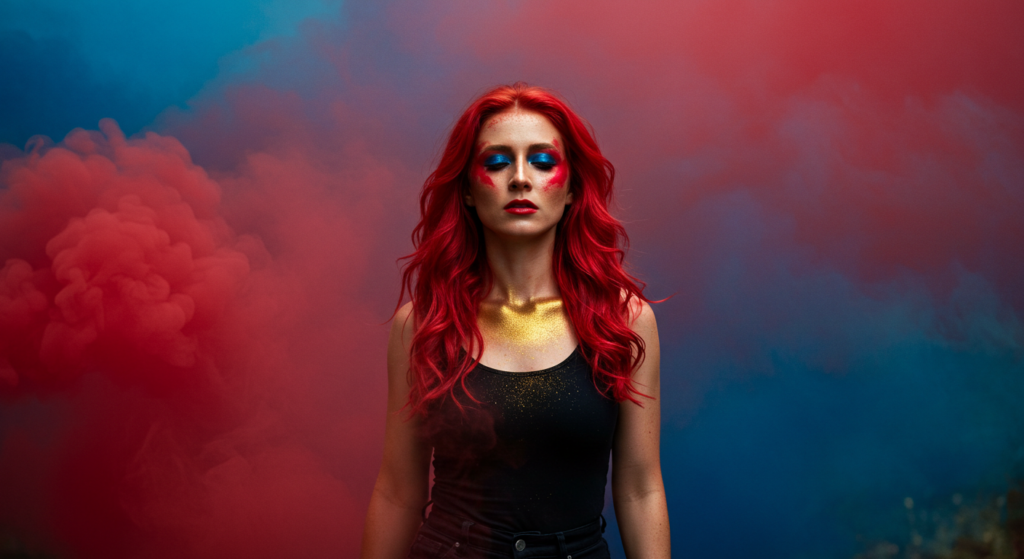
14.1 Mindset Matters
Color psychology in makeup isn’t just about the external. It connects to how you feel inside. If you believe that wearing bright orange lipstick will make you appear lively, you might carry yourself with more gusto. On the other hand, if you wear a shade you dislike, you might feel unsure all day. That’s the mental side of color.
Sometimes, it helps to experiment in small steps. If you’ve always worn neutral tones, introduce color gradually so you don’t shock yourself. Over time, you might grow comfortable with bolder hues. Makeup can be a playground for self-expression. Let your mind stay open, and see what resonates with you. A color that once seemed terrifying may become your new favorite.
14.2 Small Doses of Confidence
Even a small detail can change your mood. A bright teal accent under your lower lash line might remind you that you’re allowed to be creative. A shiny red nail polish might prompt you to feel unstoppable when typing on your keyboard. We sometimes overlook these mini transformations, but they add up.
If you’re scared of color, try it at home when no one’s watching. Pose in the mirror, test how it feels. Ask yourself: Does this color lift me or does it feel off? If you like it, keep it. If not, no harm done. The process of discovering your favorite colors can boost your confidence. That confidence may extend to other parts of your life.
14.3 Embracing Your Personal Palette
At the end of the day, color psychology is about finding your personal palette—shades that resonate with you and help you face the day boldly. Trends come and go. One season it’s all about neon, the next it’s all about browns and neutrals. Pay attention to trends if you enjoy them, but don’t feel forced. The real strength is knowing what makes you feel alive.
If that means wearing electric-blue eyeliner to a grocery run, do it. If that means always picking a classic red lip, that’s great too. No two people share the exact same relationship with color. So trust yourself. Over time, you’ll develop a sense for which hues bring out your best features and personality. And that’s the beauty of it.
Conclusion
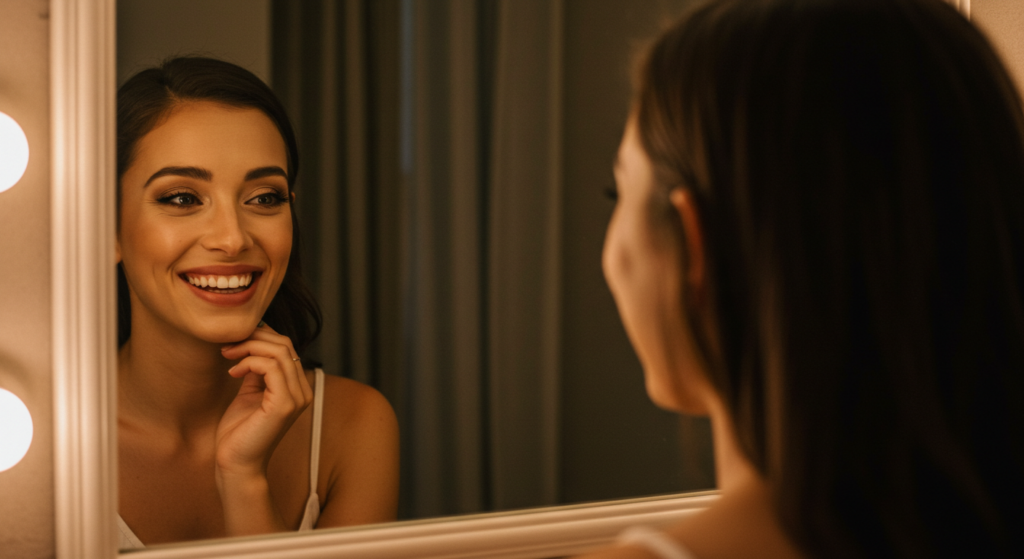
Color in makeup is about more than looking pretty. It has the power to nudge your feelings, to inject excitement into a dull day, or to calm you when you’re nervous.
We’ve explored everything from how colors affect mood, to how to apply them in ways that flatter your face, to picking the right combos for different events. It might feel like a lot, but you don’t have to absorb it all at once.
If you focus on one area—like finding your perfect red lip or experimenting with a soft green eyeliner—each small step can help you discover new sides of yourself.
Let your makeup serve as both a creative outlet and a confidence booster. Whether you opt for bold oranges, plush pinks, regal purples, or timeless neutrals, the color you choose can be a form of self-expression. Ready to open that new palette and play?
Summary Table
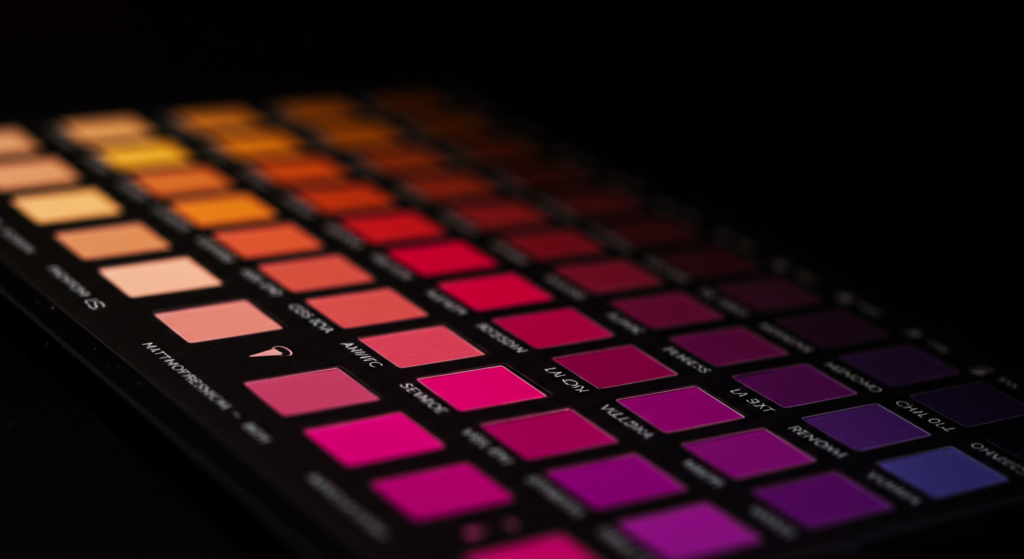
| Color | Emotional Effect | Makeup Ideas |
|---|---|---|
| Red/Orange | Energy, excitement, assertiveness | Bold lip, coral blush, orange eyeliner in small doses |
| Pink | Warmth, affection, playful | Pastel pink highlight, bubblegum lip, dusty rose for elegance |
| Blue | Calmness or lively pop (cobalt) | Navy smoky eye, baby blue liner, bright cobalt for corners |
| Green | Freshness, nature-inspired | Olive smoky eye, emerald shimmer, subtle jade eyeliner |
| Purple | Creativity, mystery, regal vibes | Plum lipstick, lavender wash, violet eyeliner |
| Neutrals | Classic, refined, balanced | Taupe crease, brown liner, subtle beige lid |
| Metallics | Glamour, shine, dramatic effect | Gold highlight, silver liner, rose gold or bronze touches |
FAQ
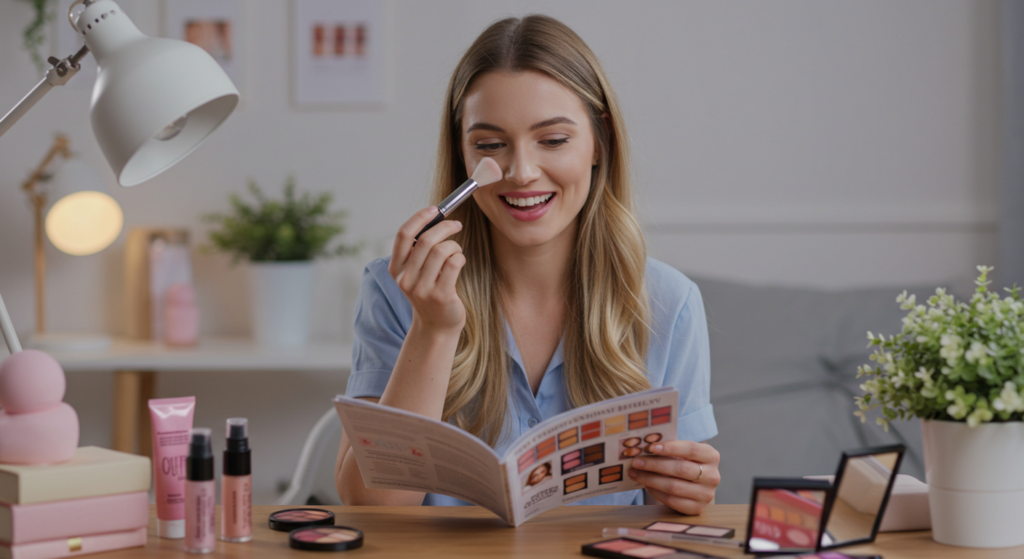
Q1: Will wearing bright colors make me look clownish?
A1: Not if you blend and choose shades that flatter your undertone. Start with a small pop, like a bright liner or bold lip, and see how you feel.
Q2: How do I know which colors match my skin’s undertone?
A2: You can test by looking at the veins on your wrist. If they appear blue, you might be cool-toned; if they look greenish, you might be warm-toned. But these are just guidelines. Experiment on your actual skin to confirm.
Q3: Is it okay to wear matching eyeshadow and lipstick colors?
A3: Yes, as long as you maintain balance. If you go for a purple shadow, pick a lighter or deeper shade of purple for your lips so they’re not exactly the same hue. Contrast or complement is key.
Q4: Do I have to adjust my makeup colors for each season?
A4: You don’t have to, but it can be fun. Seasonal shifts can inspire new shades or finishes. Use it as a creative guide, but wear what you love all year.
Q5: Should I avoid color if I’m over a certain age?
A5: Absolutely not. Color has no age limit. You can adapt application methods to fit your style and comfort. A toned-down or softer shade might work, but feel free to go bold if it brings you joy.
Go ahead and experiment. See how your confidence blooms with each new hue you try. Whether you step out wearing a bold lip or a simple neutral eye, remember that color is your friend—it’s a way to express your mood, highlight your features, and step into life with a little extra pep. Enjoy the journey!
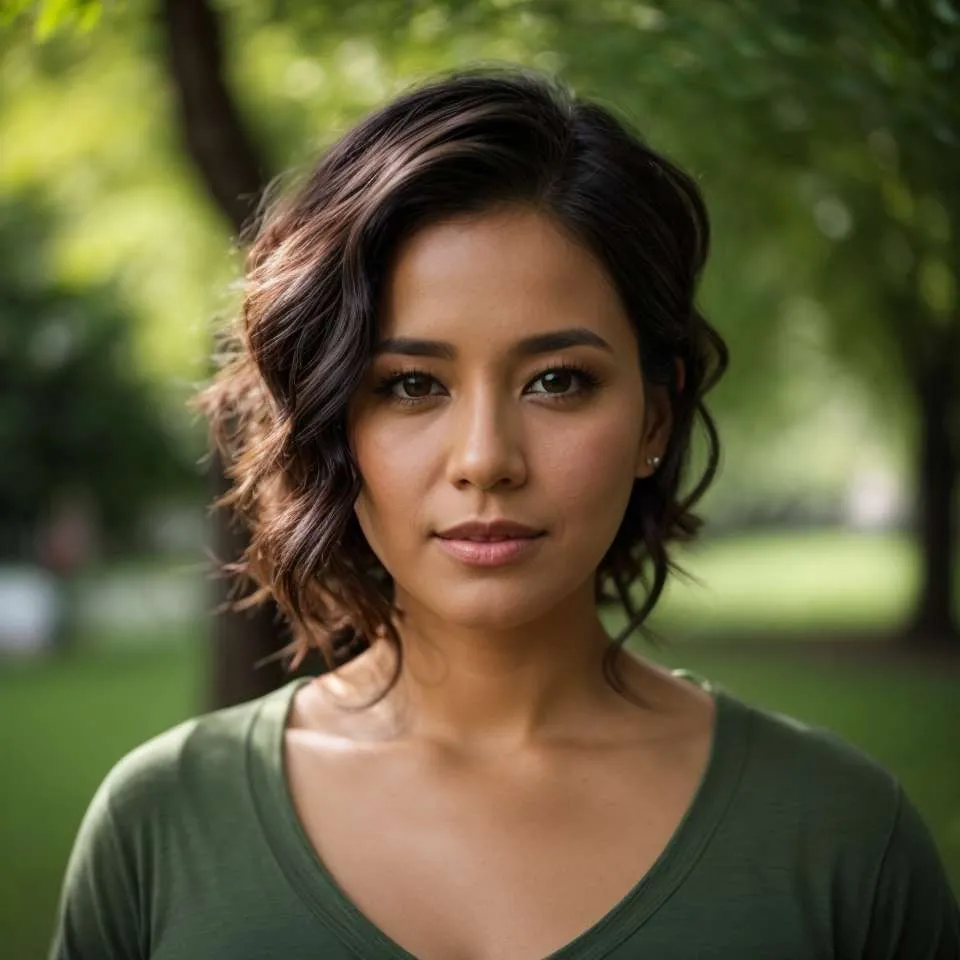
Joanna Perez, with a degree in Creative Writing, excels in recommending distinctive clothing color mixes and trends that deeply connect with readers. She simplifies the often daunting task of color selection, making fashion decisions more personalized and impactful. Her passion for vibrant color palettes and the stories they tell makes her an indispensable voice in the fashion community.
Reviewed By: Marcella Raskin and Anna West
Edited By: Lenny Terra
Fact Checked By: Sam Goldman
Photos Taken or Curated By: Matthew Mansour
